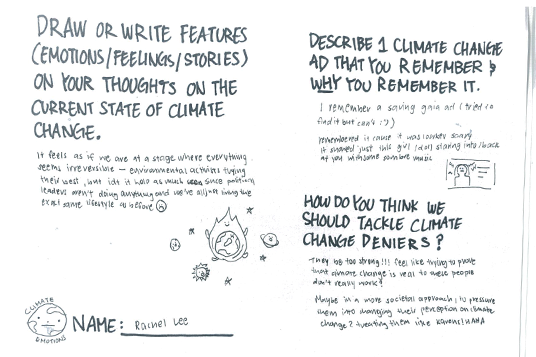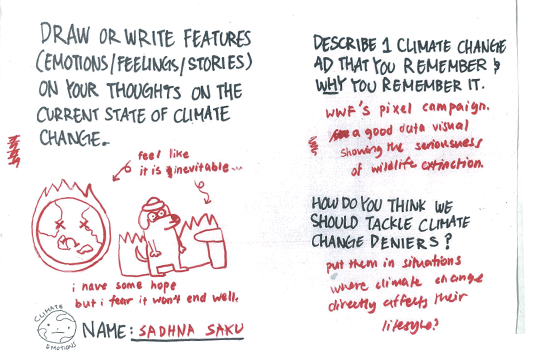- Week 4
- September 5'22

1. Readings — Perceptions on Climate Change
Psychological distance as a key barrier towards climate change.

Psychological distance is one of the main psychological constructs that explain the concrete or abstract perceptions of objects or events surrounding an individual. It explains why, for example, certain memories feel very recent even though they happened long ago for us, yet feels distant for others. There are 4 categories of psychological distance, which are temporal, spatial, social, and experiential distances. PD was developed as part of Trope and Liberman’s construal level theory (CLT), which suggests that PD changes the way we make decisions, albeit not necessarily claiming that making an issue proximal results in increased action. It has been used to study: Social psychology, effectiveness of persuasive messages and consumer psychology.
However, psychological distance in the context of climate change is a dynamic, context-specific, multidimensional construct, with a wide variety of approaches to measurement and manipulation. Current theorizing (primarily Construal Level Theory) is insufficient in describing the diversity and complexity of distance in the climate-change context.
The intangibility of climate change presents as one of the key barriers to climate change interventions. People remain unaware of the impact of their everyday actions towards climate change because it does not naturally translate into feedback from the environment. Emerging studies have attributed psychological distance as a means to explain why climate change issues often feel far-removed. Analysis of the existing literature has shown evidence that in general, experiencing psychological distance plays a role in provoking pro-environmental or resilient behaviors . However some studies have also yielded inconclusive results due to inconsistencies in how psychological distance is utilized to explore the complex and diverse issue of climate change.
↘ Construal level theory on psychological distance ↘ Psychological distance and climate change ↘ Climate Science Denial1. Readings — Design Thinking
Pointers on a good designer’s mindset
↘ Design Kit by IDEOIterate, Iterate, Iterate. Moving through concepts more quickly through testing Arrive at better solutions Allow us to test early on through various hypotheses so we don't spend too much time on a single idea that might not even be the best solution in the end.
Be optimistic. Believe that it's possible Bigger the problem, the more essential optimism is Optimism drives you forward. The art of possibility
Embracing Ambiguity: Design thinking is the process of coming up with new ideas We don't know what the answer is at the start and Might be uncomfortable, but embrace ambiguity to explore different kinds of possibilities
Empathy: Understand the people you're designing for Getting to know new people, scenarios, places Dive into something different If you’re not surprised, you’re doing it wrong
2. Casual Survey
Climate change is arguably one of the most pressing issue of our time. Although climate deniers are an issue, on the opposite end of the spectrum, climate anxiety is also a very real problem. It is often characterized by pessimistic thinking that its too late to do anything about the climate change; hence, the current political landscape of climate change could be described as being in a state of Denial vs Doom.
↘ Superflux: More than human designAs an attempt to get a first-hand observation, I created a casual survey and distributed them amongst my peers. The first question in the survey asks the person to draw or write their current feelings or thoughts towards climate change. As an avid doodler, I believe that sometimes drawings could communicate much better than words. The second question asks the audience to list down an ad or campaign talking about climate change that was very impactful to them. The third question asks the audience what they think we should do to convince climate deniers that climate change is not a hoax.
General observation
It was really interesting to see my peer's varied responses, and especially their drawings. Generally, the mood around climate change is quite negative, ranging from hoplessness to confusion and anger. When questioned about how they think climate deniers could be convinced about the issue, almost all of them said some form of "experience".
What are possible interventions to tackle the hyper-partisan media atmosphere? to tackle psychological distance? to empower micro-revolutions that could lead to a big social shift? Global warming is a trend but instead of people becoming numb to the urgency of climate change, why not slowly habituate the good actions?
2. Possible ideas with key in 'experience'
Make people experience deforestation, forest fires, and degradation in a micro level at the comfort of their homes through their everyday habits to bridge the psychological gap people experience with the issue. OR Devising mini experiments that tackle the 4 categories of psychological distance (spatial, temporal, experiential, and social), and quantifying the results to see how they could be applied in the context of climate change awareness.

3. Weekly Roundup — Mess
Aim of the project
Use design thinking as a milestone. Each milestone uses a different method (empathy..prototyping..criteria for testing prototype, etc) Steps in order to conduct the methods.
This week during our graduation project class, we got to experiment with a research method of our own choosing and then discuss our topics in pairs. I spent my time exploring 2 ideation methods, which were Problem Framing and Theory of Change. I chose to do the Problem Framing exercise to help build a foundation for the research and narrow down my approach. I also chose to do the Theory of Change exercise to help me identify a certain behavior change I wanted to see happen as an aim of my project. I realized that identifying an angle of approach to my topic is critical to be able to advance forward. Is it to raise awareness? Is it to experiment on the effectiveness of the advertisement, or to educate? Would educating people to be enough to spark a change? Why would they care? These are the questions I want to answer as my homework for next week.
Communication/ Conversing with people Question? Is it comparing ways to see if something works or not? Or comparing different sensory techs? Is it to create awareness? Is it to instigate behavioral change? Is it looking into guerilla marketing? Have the main idea, see how you can make the low-fi version of it, see what interactive media there is, hypothesis the user reaction, find backings and theories to the conclusion
How do we voice this issue on a more personal level for the audience? I believe by answering these questions would be useful to my project planning in the long run and frame the research in a more concrete way.
To Do:
Collect more case studies that focus on interactions created by utilizing the 5 different senses.
Collate all my ideas on miro or sketch them out.
Read Read Read and document everything.
RPO bullet points











